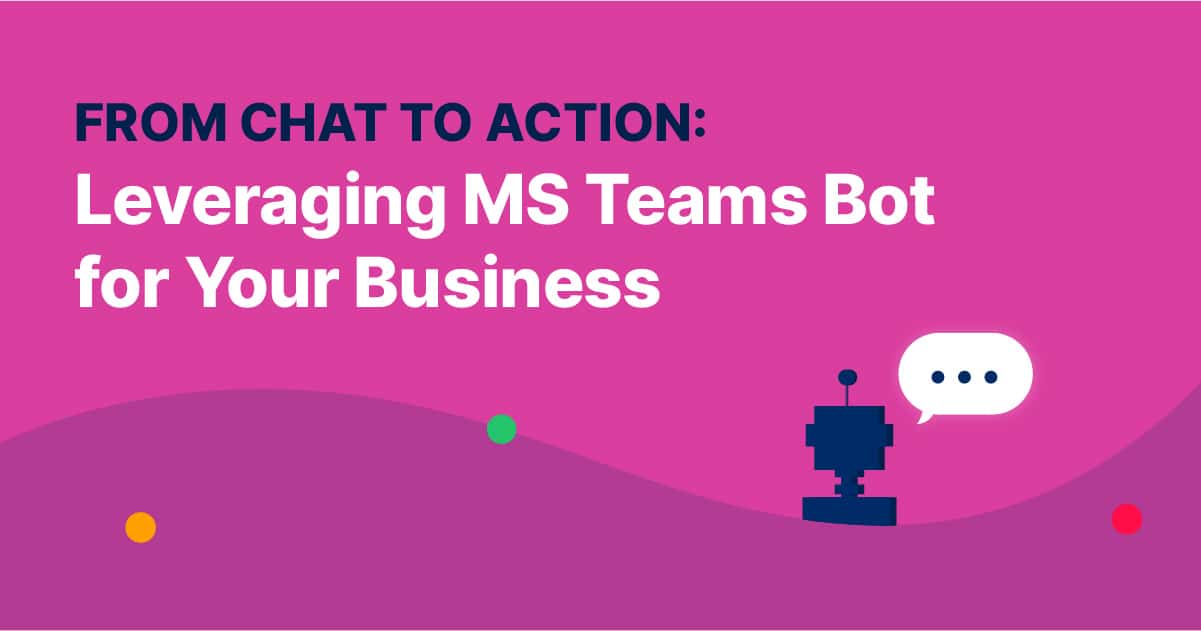It’s the 21st century – Businesses must keep up with the latest technology trends to stay competitive. In the current climate, technology has taken center stage, and there is an increasing need to incorporate AI technology to enhance customer support, streamline communication, and improve productivity. One such technology that has gained traction is the MS Teams bot. In this article, we will explore what an MS Teams bot is, how to use it, its benefits for businesses, and some use cases.
Let’s get started!
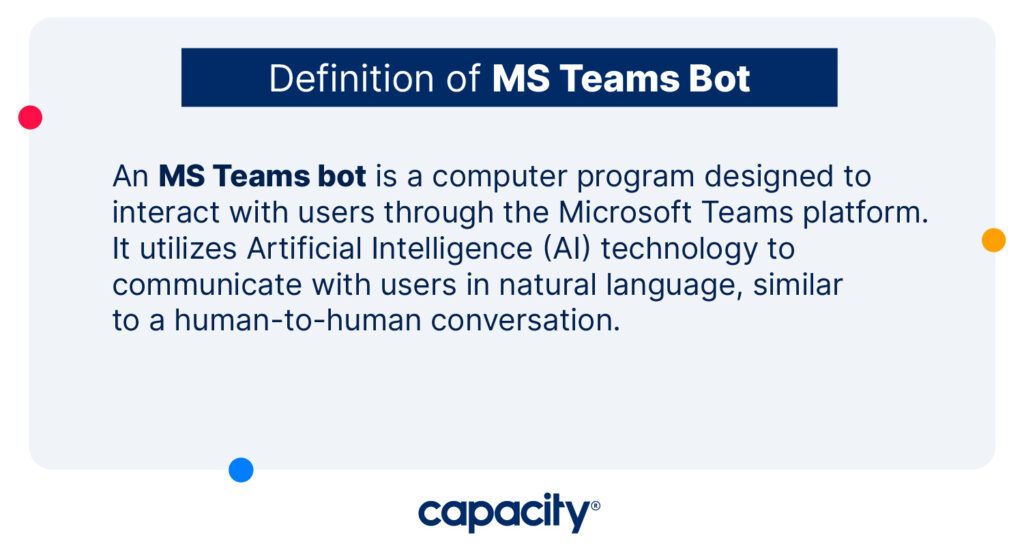
What is an MS Teams Bot?
An MS Teams bot is a computer program designed to interact with users through the Microsoft Teams platform. It utilizes Artificial Intelligence (AI) technology to communicate with users in natural language, similar to a human-to-human conversation.
MS Teams bots can be integrated into chat channels, allowing users to interact with them in real-time. The bot can be programmed to perform various tasks, such as scheduling meetings, providing information, and answering frequently asked questions.
Step-by-Step Guide: How to Use AI Technology on MS Teams
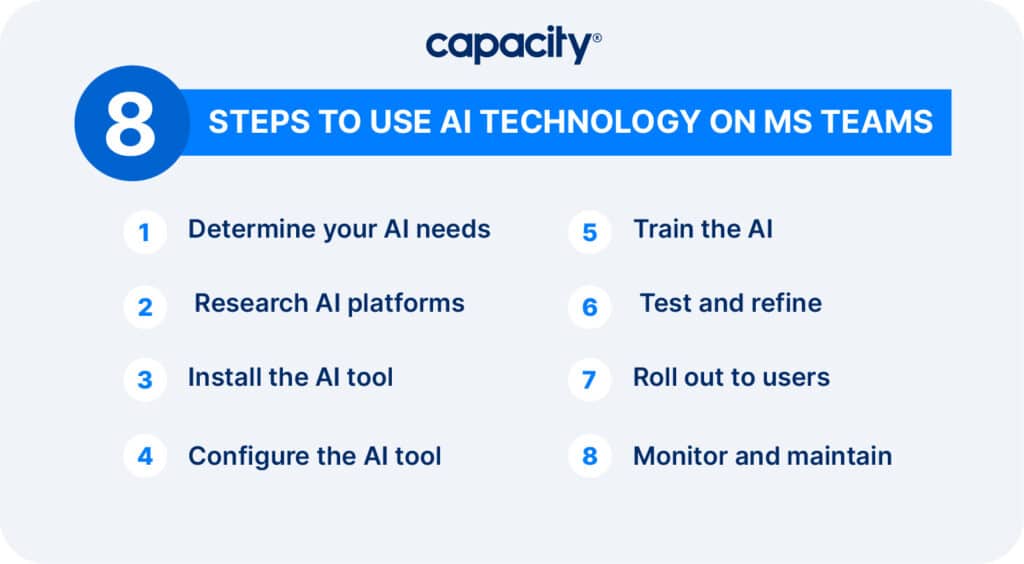
Here are the steps that you can follow:
Step 1. Determine your AI needs
The first step is identifying what tasks you want AI to perform on Teams. Are you looking to automate customer support, schedule meetings, or improve collaboration? Knowing your needs will help you select the right AI tool for your organization.
Step 2. Research AI platforms
Once you’ve determined your needs, research AI platforms integrating with Microsoft Teams. Look for features that align with your needs and compare pricing, ease of use, and user reviews.
Recommended AI platform: Capacity
Capacity is an AI-powered support automation platform that connects your entire tech stack to answer questions, automate repetitive support tasks, and build solutions to any business challenge.
See how Capacity can seamlessly integrate with platforms like Microsft teams to automate over 90% of tedious support processes.
Step 3. Install the AI tool
After selecting an AI platform, install the app on Microsoft Teams. Most AI tools offer simple integration guides that are easy to follow.
Step 4. Configure the AI tool
Once installed, configure the AI tool to match your business processes. Examples include:
- Setting up automation rules
- Customizing responses
- Integrating with other apps
Step 5. Train the AI
Depending on the AI tool, you may need to train the AI to perform specific tasks. This involves feeding the AI with data to help it learn how to respond to user inquiries or perform certain actions.
Step 6. Test and refine
After configuring and training the AI, test it to see how it performs. Monitor its performance and make adjustments as necessary to improve accuracy and efficiency.
Step 7. Roll out to users
Once you are satisfied with the AI’s performance, roll it out to users in your organization. Provide training and support to ensure users understand how to interact with the AI and get the most out of its features.
Step 8. Monitor and maintain
Continue to monitor the AI’s performance and make adjustments as necessary to ensure it continues to meet your needs. Regularly maintain the AI platform to ensure it stays up-to-date and secure.
Incorporating AI technology into Microsoft Teams can help streamline business processes and improve collaboration. By following these steps, you can successfully integrate AI tools into your organization and reap the benefits of automation.
How to Train Your MS Teams Bot to Improve its Performance?
Training your MS Teams bot is an essential step in improving its performance. Here are some tips for effectively training your bot:
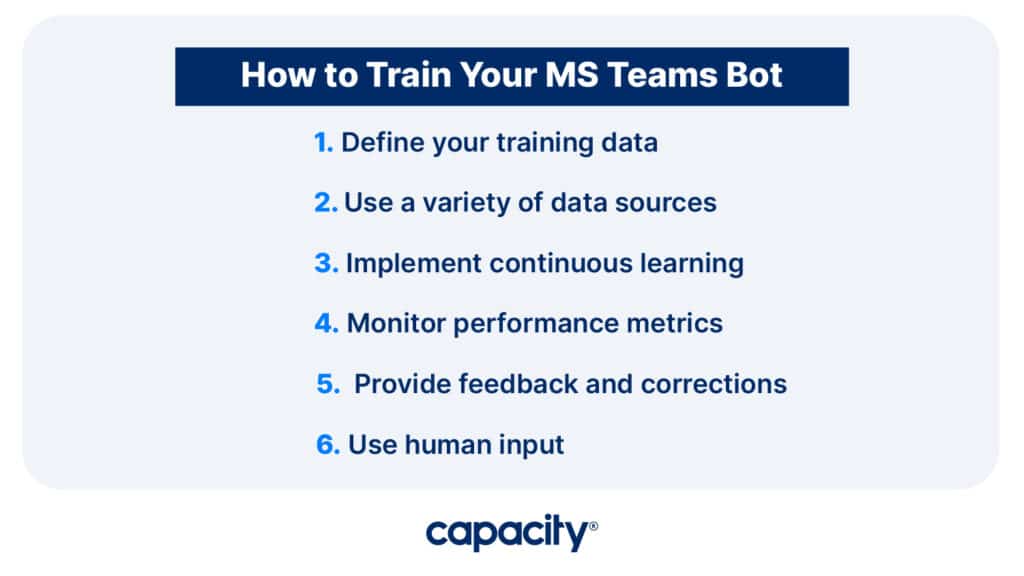
Define your training data
The first step in training your MS Teams bot is to define the data it will use to learn. Examples can include:
- Existing conversations
- Interactions with users
- External data sources
Use a variety of data sources
Using various data sources is crucial to ensure that your bot is trained correctly. These can consist of:
- Chat logs
- Support tickets
- User feedback
- Social media data
Implement continuous learning
Consider implementing continuous learning practices to ensure that your MS Teams bot continues to improve over time. This can include regularly updating training data and using machine learning algorithms to automatically adjust the bot’s behavior based on user feedback.
Monitor performance metrics
On your MS Teams bot, monitoring performance metrics such as response time, accuracy, and user satisfaction is essential. This can help you identify areas for improvement and optimize your bot’s performance over time.
Provide feedback and corrections
Providing feedback and corrections to your MS Teams bot is important during training. Some improvements include:
- Correcting errors
- Providing additional context to improve accuracy
- Adjusting behavior based on user feedback
Use human input
While machine learning algorithms can help automate the training process, human input is also important. This can consist of having human operators review and approve bot responses or allowing users to escalate to a human representative when necessary.
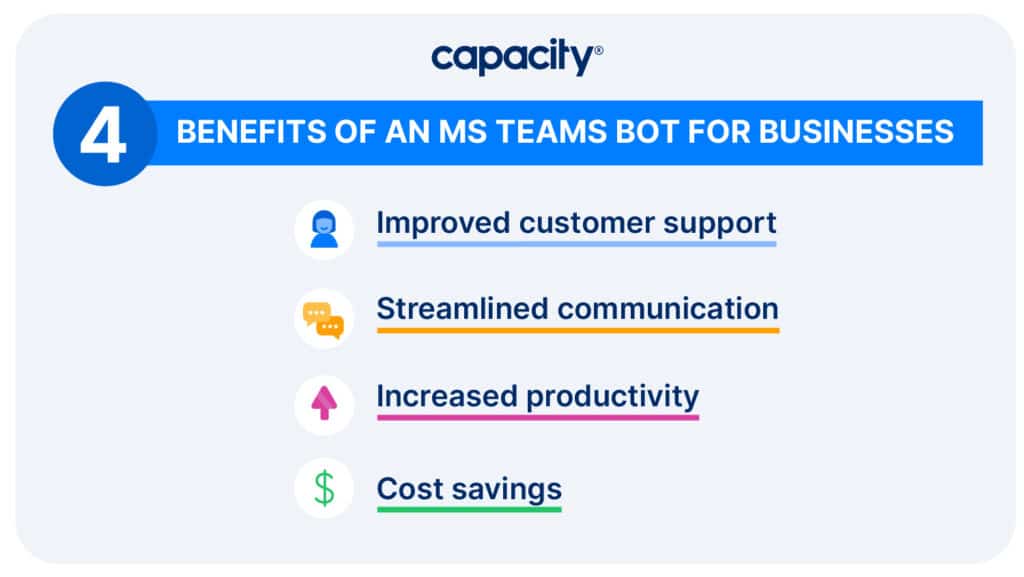
Benefits of an MS Teams Bot for Businesses
Here are the benefits:
Improved customer support
One of the primary benefits of an MS Teams bot is improved customer support. The bot can be programmed to provide customers with quick and accurate responses to their queries, reducing wait times and enhancing the overall customer experience.
Streamlined communication
An MS Teams bot can be integrated into chat channels, making it easier for team members to communicate with each other. The bot can provide information, schedule meetings, and perform other tasks, freeing team members to focus on more complex tasks.
Increased productivity
MS Teams bots can be programmed to perform repetitive tasks, allowing team members to focus on more complex and value-adding tasks. Implementing this can enhance the overall productivity and unleash the full potential of your team.
Cost savings
MS Teams bots can help businesses save costs by reducing the need for human intervention in routine tasks. This can result in significant cost savings, particularly in large organizations with many employees.
MS Teams Bot Samples and Use Cases
There are a variety of use cases and sample bots for MS Teams that businesses can use to improve their operations. Here are some examples:

- HR Support Bot – An HR support bot can help employees with common HR-related questions like payroll inquiries, benefits information, and time-off requests.
- IT Support Bot – An IT support bot can assist with technical issues such as password resets, software installations, and troubleshooting.
- Sales Bot – A sales bot can provide information about products and services, answer frequently asked questions, and help customers make purchases.
- Customer Support Bot – A customer support bot can assist with customer inquiries such as order status, returns, and refunds.
- Training Bot – A training bot can provide employees with on-demand training and support for specific tasks or processes.
Businesses can improve operations, reduce costs, and enhance the overall customer and employee experience on MS Teams by using these use cases or creating custom bots tailored to their needs.
Best Practices and Tips for Designing an Effective MS Teams Bot
When designing an effective MS Teams bot, several factors must be considered. Here are some tips that can help:

- Identify the problem you want to solve – Before designing an MS Teams bot, it’s crucial to identify the problem you want to solve. Consider what types of questions or tasks your bot will be able to assist with and how they will fit into your overall business strategy.
- Keep it simple – When designing your bot, keep the user interface as simple and intuitive as possible. Users should be able to interact with the bot without spending time learning how to use it.
- Use natural language processing – To make your MS Teams bot more effective, consider using natural language processing (NLP) technology. This will enable your bot to understand and respond to natural language queries more humanistically.
- Provide multiple options – Present users with numerous options for interacting with your MS Teams bot. This can include buttons, menus, and free-form text input.
- Ensure consistency – Consistency is key when designing an MS Teams bot. Use consistent language and design elements throughout the bot to ensure users have a consistent experience.
- Test, test, test – Before launching your MS Teams bot, ensure it works as intended. This can include testing it with real users to gather feedback and identify areas for improvement.
Capacity – The Best Platform For Leveraging MS Teams Bot for Your Business
The best platform for using MS Teams bot for your business is Capacity.
Capacity is an AI-powered support automation platform that can connect your entire tech stack to automate support tasks, answer questions, and build solutions for any business challenge. With its low-code platform and conversational AI, Capacity empowers teams to answer FAQs, automate tasks, and build solutions. It is an ideal platform for businesses using MS Teams bot technology.
With Capacity, teams can increase productivity, reduce support ticket queues, and empower employees to access information via a user-friendly knowledge base and a suite of app integrations.
Get started and try Capacity for free today!


